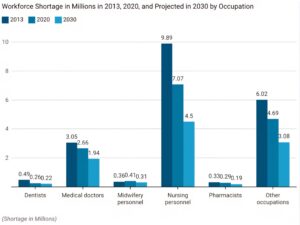Tap Healthcare Solutions is a permanent recruitment firm specializing in the healthcare industry. This article explores the persistent and evolving labor shortage facing healthcare organizations, the factors driving it, and what it means for talent strategy today and tomorrow.
There is no consensus on a specific timeline
Divergent forecasts. Industry projections vary widely on when the healthcare labor shortage might subside, and many expect the gap to persist for years or even decades.
Optimism with caveats. While some indicators hint at future workforce growth, the core drivers, aging populations and chronic burnout—are long-term issues unlikely to fade quickly.
Implications for planning. Organizations should plan with uncertainty in mind, prioritizing durable, quarterly-to-yearly talent strategies rather than one-time hiring pushes.
Persistent shortages: what the data suggests
Physician supply gaps. The Health Resources and Services Administration (HRSA) projects a shortage of more than 187,000 physicians by 2037.
Nursing workforce nuances. Some projections suggest the nurse supply-demand gap may narrow over time, but it is unlikely to fully dissipate by 2037.
Regional variability. Shortages will not be uniform. Mercer projects an overall healthcare worker shortage of about 100,000 by 2028, with pronounced regional and specialty differences. Rural areas and underserved urban communities are expected to bear the brunt.
Sector-specific dynamics. Certain settings, especially nursing homes and intensive mental health facilities, are struggling to return to pre-pandemic employment levels, while other sectors have rebounded more quickly.
Key factors contributing to the sustained shortage
The shortage is driven by multiple interlocking, long-term trends rather than a single issue. The main drivers include:
Aging demographics. The U.S. population is aging rapidly, with more than 10,000 people turning 65 each day. This trend elevates demand for healthcare services while shrinking the near-term pool of active workers due to retirements.
Burnout and turnover. Prolonged stress, high workloads, and dissatisfaction, amplified by the pandemic—are fueling burnout and turnover, reducing retention and increasing vacancy rates.
Supply constraints. Education pipelines for physicians, nurses, and allied health professionals have faced bottlenecks, delays, and capacity limits that slow the scaling of the workforce.
Geographic maldistribution. Even when national totals look adequate, shortages concentrate in rural areas and underserved urban markets, limiting access for many communities.
Job-content and attrition dynamics. Intense care settings, regulatory pressures, and evolving clinical roles contribute to job dissatisfaction and higher attrition in specific sectors.
Implications for healthcare organizations
Strategic workforce planning is essential. Given the uncertain timeline and regional disparities, organizations should adopt adaptable, long-range talent plans that incorporate scenario planning.
Diversified sourcing and retention strategies. Relying on a single recruitment channel or a short-term solution is insufficient. A mix of permanent hires, targeted outreach, and robust retention programs is critical.
Investment in well-being and development. Burnout mitigation, mental health support, manageable staffing models, and clear career pathways can improve retention and job satisfaction.
Regional talent strategies. For rural and underserved markets, partnerships with educational institutions, loan repayment programs, and community-based recruitment can help bridge gaps.
Specialty-focused staffing. Since shortages vary by specialty, targeted pipelines for high-need fields (e.g., primary care physicians, geriatric nursing, mental health professionals) are particularly valuable.
How Tap Healthcare Solutions can help
Permanent placement expertise. We specialize in high-quality permanent hires for healthcare organizations, aligning candidate qualifications with your long-term needs.
Strategic workforce planning. Our consultants assist with scenario planning, turnover analysis, and regional capacity assessments to future-proof your staffing.
Targeted talent pipelines. We build and nurture pipelines for critical and hard-to-fill roles, focusing on specialties and underserved regions where shortages are most acute.
Cultural and organizational fit. Beyond credentials, we assess alignment with your mission, values, and operational rhythms to improve retention.
Retention-focused onboarding. We will collaborate on onboarding and early-career development programs to reduce time-to-competency and boost job satisfaction.
Practical steps for navigating the shortage today
Assess current and near-future needs. Conduct a comprehensive workforce needs analysis for the next 12–36 months, broken down by role and region.
Develop a flexible hiring playbook. Create tiered recruiting plans that can scale up or down with demand, including contingency pathways for critical roles.
Strengthen training pipelines. Partner with nursing schools, medical residency programs, and allied health training institutes to create direct-to-permanent pathways.
Enhance retention. Invest in burnout prevention, flexible scheduling, competitive compensation packages, and professional development opportunities.
Leverage technology and automation thoughtfully. Use telehealth and supportive clinical technologies to optimize staffing without compromising quality of care.
Focus on underserved regions. Implement targeted outreach and incentives to attract talent to rural and urban underserved areas.
Monitor market signals. Keep a pulse on HRSA, Mercer, and other reputable forecasts to adjust strategy as conditions evolve.
In Closing:
There is no clear timeline for when the healthcare labor shortage will ease, and the drivers are long-term. Organizations that plan for uncertainty, invest in resilient talent strategies, and partner with specialist recruiters like Tap Healthcare Solutions will be best positioned to maintain high-quality patient care in this evolving landscape.

